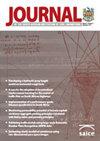Developing a hydraulic jump length model on horizontal rough beds
IF 0.6
4区 工程技术
Q4 ENGINEERING, CIVIL
Journal of the South African Institution of Civil Engineering
Pub Date : 2019-01-01
DOI:10.17159/2309-8775/2019/v61n3a1
引用次数: 2
Abstract
INTRODUCTION A hydraulic jump causes kinetic energy dissipation downstream of the hydraulic structures, whenever the flow regime is changed from supercritical to subcritical flow. Stilling basins are considered for energy dissipation to reduce flow energy and create conditions for the occurrence of hydraulic jump in a specific position (Jain 2001). A significant parameter to determine hydraulic jump length is the bed roughness. The results of previous studies have shown that increasing the bed roughness may cause more energy dissipation and, accordingly, may change the hydraulic jump length. Peterka (1984), in the USBR laboratory, presented a graph (Lj/y2 vs Fr1) to determine hydraulic jump length based on numerous experiments in some channels. Ead and Rajarantnam (2002) investigated hydraulic jump over corrugated aluminium beds, and developed an empirical model. They found that hydraulic jump length over corrugated bed surfaces was approximately half the classical jump length. Izadjoo and Shafai-Bejestan (2007) studied hydraulic jump over four corrugated beds. Pagliara et al (2008) determined an equation for hydraulic jump length over both uniform and non-uniform rough beds in horizontal channels. In recent years, Chanson (2009), Alikhani et al (2010), Nasr Esfahani and Shafai Bajestan (2012), Imran and Akib (2013), and Riazi and Jafari (2014) have studied the effect of drop and barrier height, divergence angle of stilling basins and rough and corrugated bed on the characteristics of hydraulic jump and energy dissipation using dimensional analysis. Kumar and Lodhi (2016) investigated the effect of bed roughness heights on the characteristics of a hydraulic jump. They concluded that the bed roughness height has no considerable effect on hydraulic jump characteristics. Due to the impact of roughness on hydraulic jump, the main aim of this study was to develop a new model to estimate hydraulic jump lengths on horizontal rough beds using dimensional analysis and physical model tests.建立了水平粗糙层的水力跃变长度模型
当流型由超临界流转变为亚临界流时,水力跃变会引起水工结构下游的动能耗散。消力池用于消能,降低水流能,为特定位置发生水跃创造条件(Jain 2001)。决定水力跳跃长度的一个重要参数是河床粗糙度。以往的研究结果表明,增加河床粗糙度可以引起更大的能量耗散,从而改变水力跃变长度。Peterka(1984)在USBR实验室提出了一个图表(Lj/y2 vs Fr1),以确定在一些通道中进行的大量实验为基础的水力跳跃长度。Ead和Rajarantnam(2002)研究了波纹铝床的水力跳跃,并开发了一个经验模型。他们发现,波纹床表面上的水力跳跃长度大约是传统跳跃长度的一半。Izadjoo和shafaie - bejstan(2007)研究了四个波纹床的水力跳跃。Pagliara等人(2008)确定了水平河道中均匀和非均匀粗糙河床的水力跳跃长度方程。近年来,Chanson(2009)、Alikhani等(2010)、Nasr Esfahani和Shafai Bajestan(2012)、Imran和Akib(2013)、Riazi和Jafari(2014)利用量次分析的方法研究了落差和障壁高度、消力池发散角、粗糙层和波纹层对水跃特性和能量耗散的影响。Kumar和Lodhi(2016)研究了河床粗糙度高度对水力跳跃特性的影响。他们得出结论,河床粗糙度高度对水跃特性没有太大的影响。由于粗糙度对水跃的影响,本研究的主要目的是通过量纲分析和物理模型试验建立一个新的模型来估计水平粗糙床的水跃长度。
本文章由计算机程序翻译,如有差异,请以英文原文为准。
求助全文
约1分钟内获得全文
求助全文
来源期刊
CiteScore
0.70
自引率
25.00%
发文量
19
审稿时长
>12 weeks
期刊介绍:
The Journal of the South African Institution of Civil Engineering publishes peer reviewed papers on all aspects of Civil Engineering relevant to Africa. It is an open access, ISI accredited journal, providing authoritative information not only on current developments, but also – through its back issues – giving access to data on established practices and the construction of existing infrastructure. It is published quarterly and is controlled by a Journal Editorial Panel.
The forerunner of the South African Institution of Civil Engineering was established in 1903 as a learned society aiming to develop technology and to share knowledge for the development of the day. The minutes of the proceedings of the then Cape Society of Civil Engineers mainly contained technical papers presented at the Society''s meetings. Since then, and throughout its long history, during which time it has undergone several name changes, the organisation has continued to publish technical papers in its monthly publication (magazine), until 1993 when it created a separate journal for the publication of technical papers.

 求助内容:
求助内容: 应助结果提醒方式:
应助结果提醒方式:


